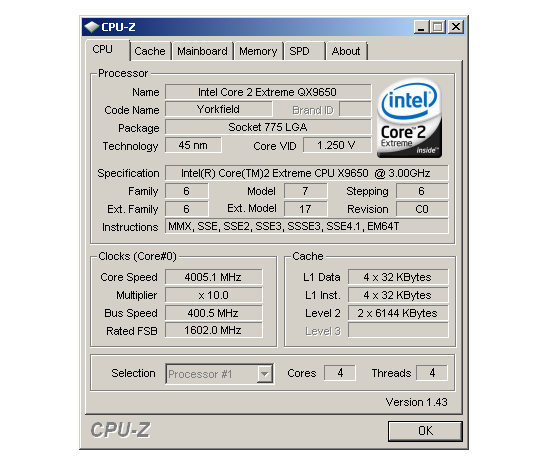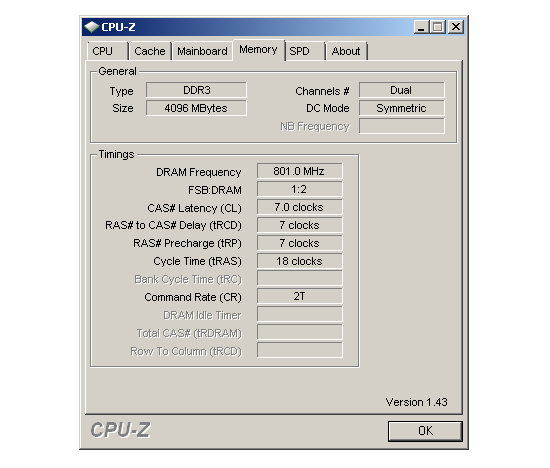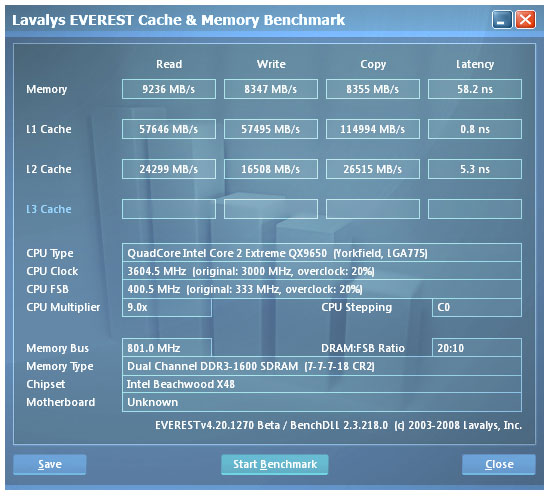MSI X48 Platinum: Four PCI Express x16 Slots to go Please....
by Kris Boughton on January 31, 2008 7:15 AM EST- Posted in
- Motherboards
A Preliminary Look at Overclocking Results
Once we were able to overcome our initial difficultly clocking our quad-core QX9650 by manually adjusting the CPU's GTL voltages, we found that the board responded well to our demands for more speed. Our focus was on achieving a balanced, stable overclock at 400MHz FSB, using the highest multiplier that the board's power circuitry and our processor could reasonably handle. In the end we settled on 10x for an even 4GHz - this placed our memory at DDR3-1600 using the 2:1 divider. Although not reported by CPU-Z, our full-load CPU voltage at this speed was about 1.28V and the X48 Platinum had no issues supplying the necessary current in a stable fashion.

Our memory timings ended up being a little looser than we would have liked. After 2.00V the board's next higher memory voltage setting was 2.17V, a little more than we were willing to give our expensive DDR3 memory simply for the purpose of setting CAS 6 instead of CAS 7. We have already discussed with MSI the need for finer fidelity when setting a DRAM voltage above 2V.

Memory read performance is certainly on par with what we expect for our settings. We are able to determine that tRD is being set to 7 by the board at an FSB of 400MHz, two whole clicks looser than we would have liked when it comes to X48. This along with setting 1N would help the memory read performance to easily eclipse 10GB/s. Write speeds are also a little low; later we were able to determine that the write recovery time (tWR) we set in BIOS at 10 clocks was being ignored and the board was defaulting to 21T. Rest assured minor problems like these will be corrected before a shipping BIOS is released.

Adding options for tRD (MCH Read Delay) and a couple other key memory timings will go a long way improving the already good memory latency time. It should be possible with a little tuning to take this number below 50ns. This is where Intel systems start to feel truly fast. We look forward to working closely with MSI in making this possible.










21 Comments
View All Comments
taylormills - Monday, February 4, 2008 - link
Hi all,Just a newbie question.
Does this indicate that sound cards will be moving to PCI Express.
Just curious because I have an older Board and am going to want to upgrade and I find it hard to fit a sound card around my twin 8800 boards. Due to them taking up the available slots.
Any info ?
karthikrg - Saturday, February 2, 2008 - link
how many ppl are using even crossfire 2x let alone think about crossfire 4x? 4 pcie slots IMHO is overkill. hope amd at least delivers crossfire x drivers in time. else it'll all be an utter waste.ninjit - Friday, February 1, 2008 - link
At the beginning of the article you mention that this is a DDR3 board, yet in the specifications chart you have lines for:[quote] DDR2 Memory Dividers [/quote]
&
[quote] Regular Unbuffered, non-ECC DDR2 Memory to 8GB total [/quote]
nubie - Friday, February 1, 2008 - link
"many x16 devices are only capable of down-training to speeds of x4 or x8 and without this bridge chip the last x1 lane would be otherwise useless." This does interest me, I have had 3 nvidia cards (2x6600GT and 6200) running on a plain jane MSI neo4 OEM (Fujitsu Seimens bios), simply by cutting the ($25) 6200 down to a x1 connector and cutting the back out of one of the motherboard x1 slots to allow the 6600GT to fit physically.I thought that part of the PCIe standard was auto-negotiation, wouldn't any device NOT compatible with x1 be breaking the standard?
http://picasaweb.google.com/nubie07/PCIEX1/photo#5...">http://picasaweb.google.com/nubie07/PCIEX1/photo#5...
I am very curious about this, as the PCIe technology doesn't seem to be getting as much use as it could(IE it is MUCH more flexible than it is given credit for). The PCIe scaling analysis at Tomshardware showed that an 8800GTS was still quite capable at x8, so on PCIe 2.0 a x4 slot could be used for gaming at acceptable resolutions! (I am fully aware that only the first 2 slots are PCIe 2.0)
The new Radeon "X2" card with 4 outputs could fit in this motherboard 3 times over, that is 12 displays on 1 PC with off-the-shelf technology!! With the quad-core and 12 displays, 2 PCs at around ~$1,000-$3,000 apiece could service a whole classroom of kids using learning software, typing tutor programs, or browsing the web. Even with regular old 2 output video cards you could get 8 displays on a much cheaper rig with sub-$50 video cards. So I wouldn't say "the performance potential of such a setup is marginal", unless I was measuring performance in such meaningless terms as how many $xxx video cards I can jam in a PC to get xx% increase.
kjboughton - Friday, February 1, 2008 - link
You are correct when you say that PCIe devices are capable of auto-negotiating their link speeds; however, not all devices will allow for negotiated speeds of only x1. This includes most video cards, which will allow themselves to train to x16, x8, and x4 speeds but not x1. They are flexible to the extent possible, but nowhere does the PCIe specification require that that all devices support all speeds...after all, cards that make use of an x8 mechanical interface are obviously incapable of x16 speeds, too...smeister - Friday, February 1, 2008 - link
What's with the memory reference voltage?On the specification page (pg 2)
Memory Reference Voltage Auto, 0.90V ~ 1.25V
It should be half the DDR3 memory voltage
1.5V x 0.5 = 0.75V, so should be: Auto, 0.75V ~ 1.25V
kjboughton - Friday, February 1, 2008 - link
If you want half of 1.50V then leave it on 'Auto'...regardless, the lowest manually selectable value is 0.90V.DBissett - Thursday, January 31, 2008 - link
I can't find it now, but a couple of days ago I found this X48 board listed on MSI's website along with an X48C which would take either DDR3 or DDR2. Would be great to be able to use it now with DDR2 and upgrade to DDR3 when the prices get sane and it becomes clear why DDR3 is better.Dave
feraltoad - Thursday, January 31, 2008 - link
almost always recommend replacing the thermal interface material (TIM)You state to replace teh TIM for the PWM and Chipset heatpipe coolers. I have a question regarding that. I have a IP35 pro, and I bought a new case. I thought now might be a good time to replace my pushpins with bolts, but I am hesitant about removing the thermal pad. I know that a direct contact to the heatpipe cooling system will result in better heat transfer, but I am afraid of shorting something out. Is it safe to have the cooler setting directly on the PWM? Does the pad also function as an insulator? I can live with a bit higher temps, but I can't live with killing my MOBO. Anyone's comments with some experience on this would be greatly appreciated.
ButterFlyEffect78 - Thursday, January 31, 2008 - link
I get 9631mb/s on my Nvidia EVGA 680i chipset at only 750mhz ddr2 with 4-4-3-5 1T.And my brother who owns an Intel P35 Foxconn Mars board gets 9132mb/sec at 950mhz ddr2 with 5-5-5-18 2t.
So what is the point on moving to ddr3 when it offers no performance gains in memory bandwidth even at a whopping 1600mhz. Is it just me who thinks Cas7 is wayyyy too high to even consider to push ddr3 to the market right now?
I believe this is what only Intel wants so it can make AMD look old just like how they forced AMD a few years ago to make AM2 boards that only supported dd2.